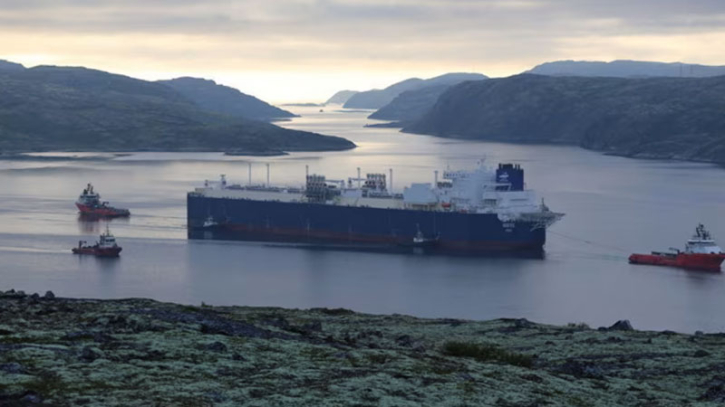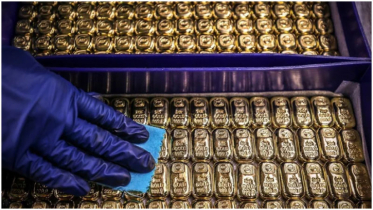Putin's flagship Arctic gas project struggles to lure customers

Russia has been forced to start storing gas from Vladimir Putin’s flagship Arctic project, in a sign that western sanctions are deterring buyers.
According to ship-tracking data and satellite images, three vessels have shipped liquefied natural gas from the US-sanctioned Arctic LNG 2 since it started loading operations last month.
One of the ships, Everest Energy, appears to have unloaded at Saam FSU, a floating storage unit anchored in a bay in the Murmansk region of northern Russia. It has since headed back in the direction of Arctic LNG 2.
The transfer “underscores the challenges that Russia faces in finding buyers for its sanctioned LNG”, said analysts at Kpler, a data and analytics platform.
The other two shipments have also remained in Russian or European waters and have not been delivered to a buyer.
Arctic LNG 2 was intended as a totemic project for the Kremlin: its planned full production had been due to account for a fifth of Russia’s annual LNG production target of 100mn tonnes by 2030, which would amount to more than three times the volume the country exports now.
Cloud-penetrating radar images taken by European Space Agency Sentinel-1 satellites show a large ship matching the Everest Energy’s size pulling up alongside the Saam FSU, though cloud cover has prevented many clear photographs from being taken of the vessels.
The US last year added Arctic LNG 2, which is led by private energy company Novatek, to its sanctions list in response to Moscow’s full-scale invasion of Ukraine.
Russia sought to counter the sanctions by amassing a “dark fleet” of LNG carriers to export the gas, but the US in late August swiftly imposed sanctions on those vessels and managing companies, which analysts and traders said has probably scared off potential buyers for now.
The first vessel to take the fuel from the project, Pioneer, transferred its LNG to an unsanctioned vessel in the eastern Mediterranean north of Port Said in Egypt in late August, but both ships have held their positions since then.
Asya Energy, the second vessel to load from the Arctic facility, had initially charted its way around the Norwegian Sea after taking on the load, but is back in Russian waters without having unloaded. It is now next to Saam FSU, ship tracking data from consultancy ICIS showed.
These ships have sought to disguise their movements by “spoofing”, or having their electronic ID transponders broadcast false positions. For example, Pioneer’s transponders indicated the vessel was in the sea north of Norway when satellite images showed it was actually picking up LNG at the Arctic facility.
Concern has been growing about such behaviour by the fleet that serves Russia’s energy industry: in June, the EU added the use of “irregular and high-risk shipping practices” to its grounds for imposing sanctions.
Pioneer, Asya Energy and Everest Energy have all had their registrations suspended by authorities in the Micronesian nation of Palau, where they were flagged, following the latest US sanctions.
Kjell Eikland, managing director at Oslo-based Eikland Energy, an energy consultancy, said: “Whatever interests buyers may have had before [the latest US sanctions] are certainly gone now.”
LNG exports add to the energy revenues that support Russia’s wartime economy, albeit at a much smaller scale than pipeline exports to Europe, which have been slashed after its full-scale invasion of Ukraine.
Novatek’s hydrocarbon sales revenues for the three months to June rose 15 per cent year-on-year, suggesting a moderate rise in shipment volumes. However, since the invasion of Ukraine, Novatek, like many Russian companies, has stopped publishing detailed breakdowns, making it difficult to gauge how much of the revenues came from Arctic LNG 2.
LNG and sanctions experts agree that because of the US sanctions, there is little chance that European countries or western-allied nations will import from the Arctic project. However, the sanctions are unlikely to fully prevent the LNG ending up in countries outside that group, analysts said.
“The history of energy sanctions tells us that someone will be willing to swallow the risk and import these volumes,” said Francis Bond, sanctions specialist at law firm Macfarlanes.
“The most likely buyers are therefore those entirely outside of the Russia ‘sanctioning coalition’, the largest of whom are India and China...[both] remain very vocal at a state level in their opposition to US extraterritorial measures.”
The two countries have become cornerstone buyers of Russian oil in the wake of the western-imposed price cap. But a report by a major Russian bank issued in May and seen by the Financial Times suggested Moscow was likely to face similar challenges with its LNG shipments to Asia to those with crude oil: buyers were expected to demand discounts.
“It is definitely an uphill battle for Novatek,” said Sergey Vakulenko, senior fellow at the Carnegie Endowment for International Peace. “The US seems to be much more purposeful [in imposing sanctions] when it comes to Arctic LNG 2” compared with its actions on oil.
“But over the years Novatek has proven themselves as an adept operator. There is some chance that they will find a way around all of this.”
Novatek did not respond to a request for comment.—Financial Times.
.png)




